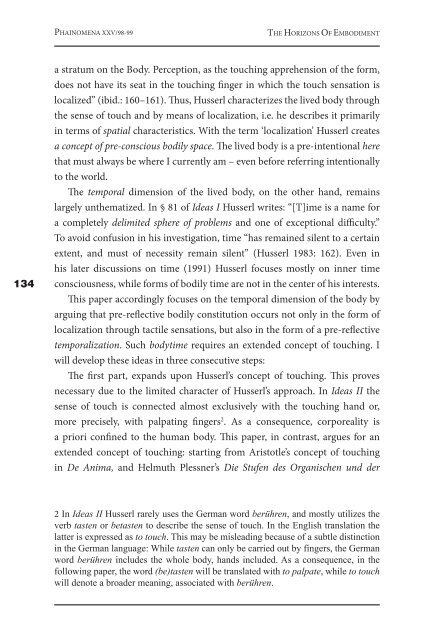phainomena
PHAINOMENA-98-99_e-verzija
PHAINOMENA-98-99_e-verzija
Create successful ePaper yourself
Turn your PDF publications into a flip-book with our unique Google optimized e-Paper software.
PHAINOMENA XXV/98-99<br />
THE HORIZONS OF EMBODIMENT<br />
134<br />
a stratum on the Body. Perception, as the touching apprehension of the form,<br />
does not have its seat in the touching finger in which the touch sensation is<br />
localized” (ibid.: 160–161). Thus, Husserl characterizes the lived body through<br />
the sense of touch and by means of localization, i.e. he describes it primarily<br />
in terms of spatial characteristics. With the term ‘localization’ Husserl creates<br />
a concept of pre-conscious bodily space. The lived body is a pre-intentional here<br />
that must always be where I currently am – even before referring intentionally<br />
to the world.<br />
The temporal dimension of the lived body, on the other hand, remains<br />
largely unthematized. In § 81 of Ideas I Husserl writes: “[T]ime is a name for<br />
a completely delimited sphere of problems and one of exceptional difficulty.”<br />
To avoid confusion in his investigation, time “has remained silent to a certain<br />
extent, and must of necessity remain silent” (Husserl 1983: 162). Even in<br />
his later discussions on time (1991) Husserl focuses mostly on inner time<br />
consciousness, while forms of bodily time are not in the center of his interests.<br />
This paper accordingly focuses on the temporal dimension of the body by<br />
arguing that pre-reflective bodily constitution occurs not only in the form of<br />
localization through tactile sensations, but also in the form of a pre-reflective<br />
temporalization. Such bodytime requires an extended concept of touching. I<br />
will develop these ideas in three consecutive steps:<br />
The first part, expands upon Husserl’s concept of touching. This proves<br />
necessary due to the limited character of Husserl’s approach. In Ideas II the<br />
sense of touch is connected almost exclusively with the touching hand or,<br />
more precisely, with palpating fingers 2 . As a consequence, corporeality is<br />
a priori confined to the human body. This paper, in contrast, argues for an<br />
extended concept of touching: starting from Aristotle’s concept of touching<br />
in De Anima, and Helmuth Plessner’s Die Stufen des Organischen und der<br />
2 In Ideas II Husserl rarely uses the German word berühren, and mostly utilizes the<br />
verb tasten or betasten to describe the sense of touch. In the English translation the<br />
latter is expressed as to touch. This may be misleading because of a subtle distinction<br />
in the German language: While tasten can only be carried out by fingers, the German<br />
word berühren includes the whole body, hands included. As a consequence, in the<br />
following paper, the word (be)tasten will be translated with to palpate, while to touch<br />
will denote a broader meaning, associated with berühren.


